Why you can trust Tom's Hardware
The AW5520QF features four HDR modes. The sole image controls they have is contrast, which only serves to adjust the highlight detail clip point. It’s best left at its default setting of 75%. We measured all four modes and determined that Reference was the most accurate. It’s aptly named because the errors are quite small.
HDR Brightness and Contrast
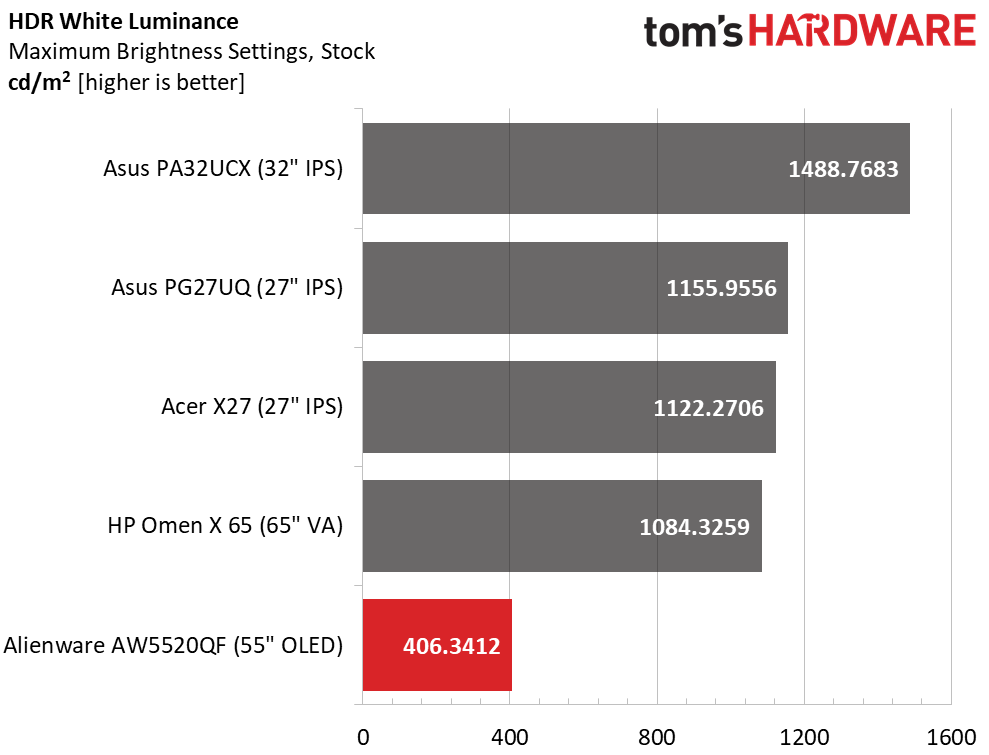
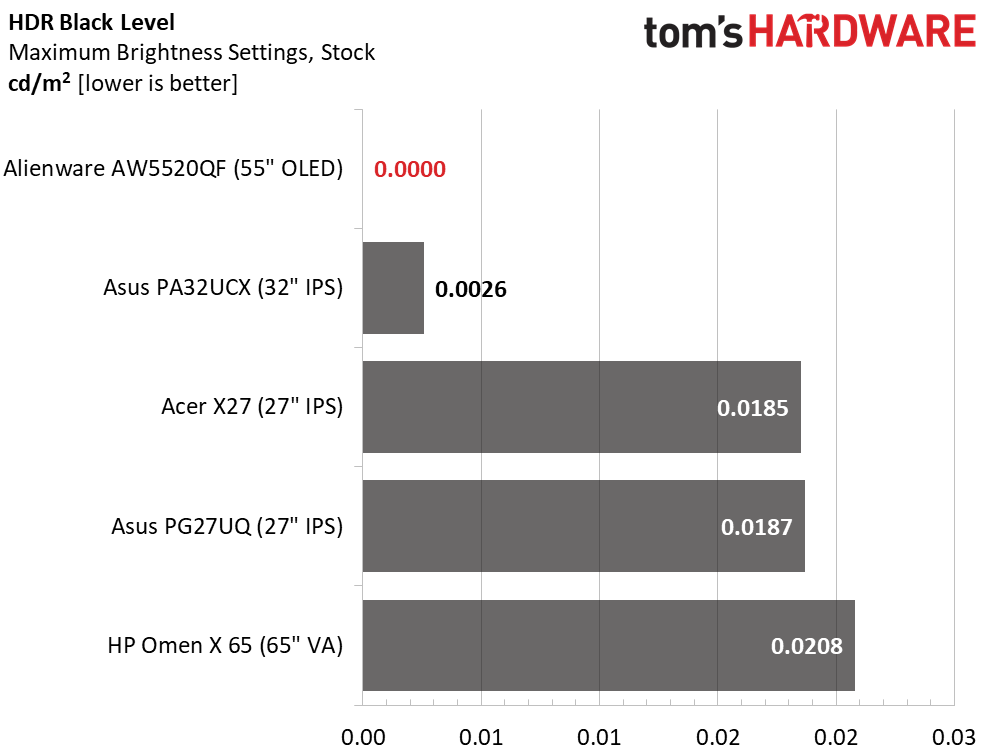
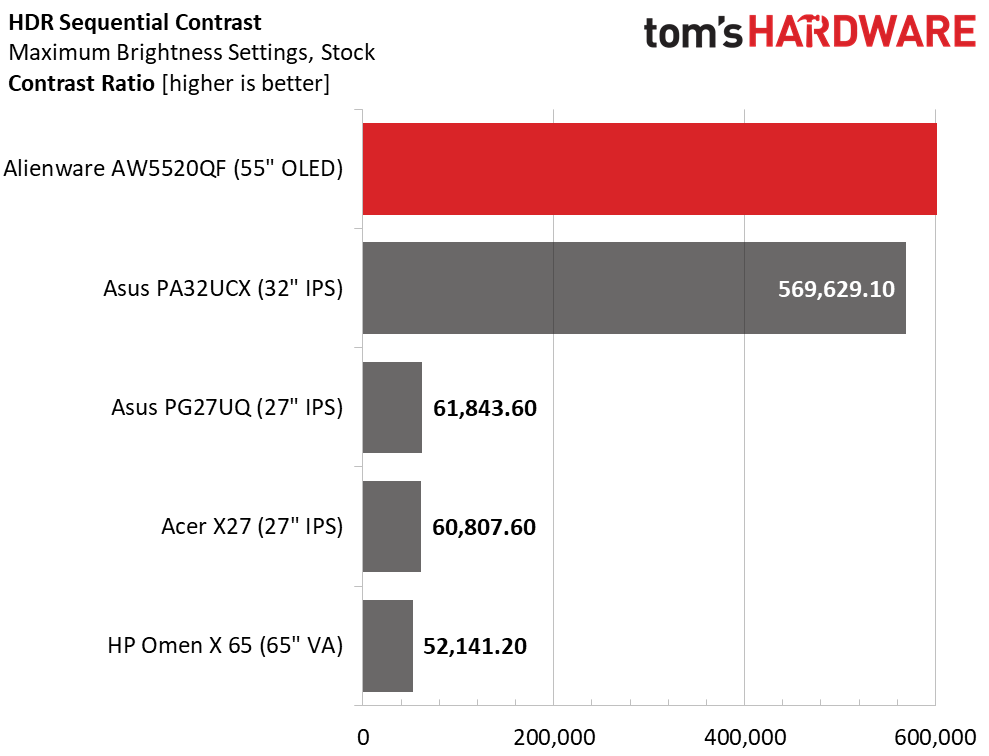
Contrast is the most important factor when considering any HDR display. While LCD monitors with FALD backlights do an excellent job at rendering deep blacks and bright whites, they can’t come close to the image depth of an OLED. LCDs have a brightness advantage, though. All the LCD panels here top 1,000 nits brightness with HDR, with the PA32UCX nearing the 1,500-nit mark. That adds depth and dimension and makes an image that holds up better under ambient lighting. But the AW5520QF, when viewed in a dark environment, is on a completely different level. To achieve the 406-nit peak we measured, we used a 5% window pattern. Again, we were unable to measure the black level, so HDR contrast is theoretically infinite.
Grayscale, EOTF and Color
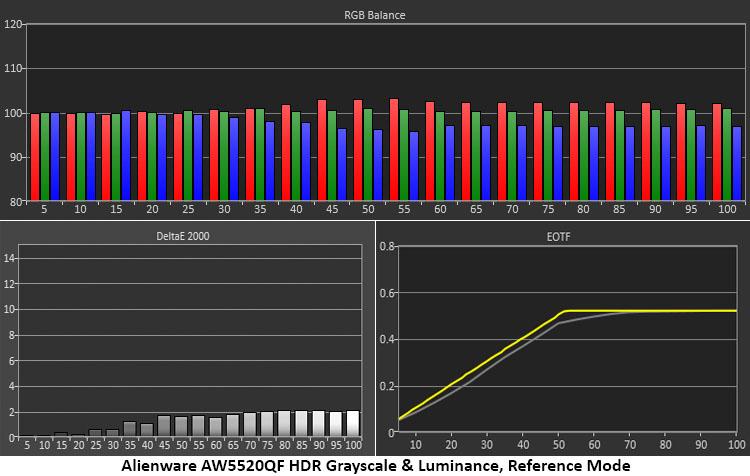
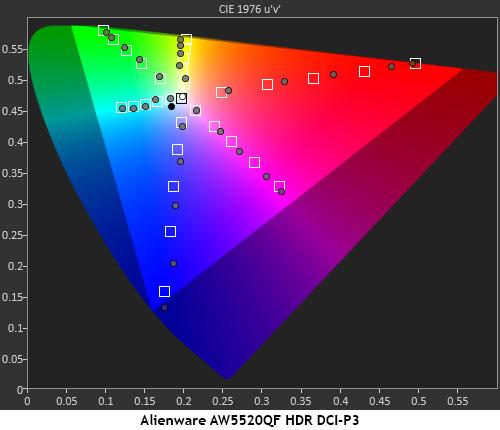

The AW5520QF’s HDR grayscale accuracy is superb with only a few errors over 2d that are invisible to the naked eye. The tone-map clip point is just over 50%, and our test shows that luminance tracks almost exactly to standard. It doesn’t get much better than this.
The monitor has nearly full coverage of the DCI-P3 gamut, which is borne out by our HDR color test. Inner points are a little over-saturated, but tracking is linear to the triangle’s perimeter. There are no significant hue errors. The AW5520QF can’t quite get to the full Rec.2020 gamut, but it tries by over-saturating at every target point. Only the Asus PA32UCX comes anywhere close to rendering this enormous gamut.
MORE: Best Gaming Monitors
MORE: How We Test Monitors
MORE: All Monitor Content
Get Tom's Hardware's best news and in-depth reviews, straight to your inbox.
Current page: HDR Performance
Prev Page Grayscale, Gamma and Color Next Page Viewing Angles, Uniformity, Response and Lag
Christian Eberle is a Contributing Editor for Tom's Hardware US. He's a veteran reviewer of A/V equipment, specializing in monitors. Christian began his obsession with tech when he built his first PC in 1991, a 286 running DOS 3.0 at a blazing 12MHz. In 2006, he undertook training from the Imaging Science Foundation in video calibration and testing and thus started a passion for precise imaging that persists to this day. He is also a professional musician with a degree from the New England Conservatory as a classical bassoonist which he used to good effect as a performer with the West Point Army Band from 1987 to 2013. He enjoys watching movies and listening to high-end audio in his custom-built home theater and can be seen riding trails near his home on a race-ready ICE VTX recumbent trike. Christian enjoys the endless summer in Florida where he lives with his wife and Chihuahua and plays with orchestras around the state.
-
nitrium Is this a "monitor"? It's more like 55" TV that has Freesync. "Monitor" is the wrong word imo - "Gaming TV" is more accurate. Also OLED has terrible burn-in, so it can't be used as a regular monitor for extended periods without damaging it with ghosting. I guess if you use it solely for gaming and TV? Oh right, it's a "gaming TV".Reply -
AlistairAB As I read this, I am using my gsync compatible LG OLED TV that I bought for $1360 USD from Bestbuy. Same 120hz at 1440p, and supposedly at 4k coming next year. So the Alienware is completely pointless at its price point.Reply -
mac_angel yea, pretty much as others say, I'd be curious to see how this measures up with LG OLED, as well as the Samsung 8000 Series and up. Samsung was first with VRR (Freesync). Pay that kind of premium over these other TVs does not seem worth it by far, but I also haven't found any proper reviews directed at gaming, or specifically PC gaming. After the past few weeks of researching, I am hoping to pick up three Samsung 55" RU8000 TVs for my computer.Reply
FYI to anyone reading. If you have a good smart phone, there are pretty decent TV calibration apps you can get for your smart phone that use the camera. As good as professional equipment? No. Better than doing it by sight? Big Yes. Especially for the money. -
tharkis842 Use my C8 for gaming/pc all the time, no burn in issues. But no-one wants to hear that. This "monitor" really makes no sense though.Reply -
jacoro1 Reply
The potential for burn in on these sets has been exaggerated. I and many others have been using OLED as a primary PC monitor for extended periods for years without any burn in issues. I even disabled the static brightness limiter in the service menu on my C9, which is meant to help prevent image retention but can be irritating for PC use. Image retention on these sets is generally rare and temporary, with a few exceptions. The LG sets have automatic maintenance routines that run on a schedule to level out wear, and I suspect this Alienware display does as well. Just do common sense things like not running it in torch mode 24/7 on a static image, and maybe have a screen saver turn on after a period of inactivity.nitrium said:Is this a "monitor"? It's more like 55" TV that has Freesync. "Monitor" is the wrong word imo - "Gaming TV" is more accurate. Also OLED has terrible burn-in, so it can't be used as a regular monitor for extended periods without damaging it with ghosting. I guess if you use it solely for gaming and TV? Oh right, it's a "gaming TV".
The price on this Alienware is a bit much though. The C9 has gsync support now and can use it in HDR with double the brightness for $1400